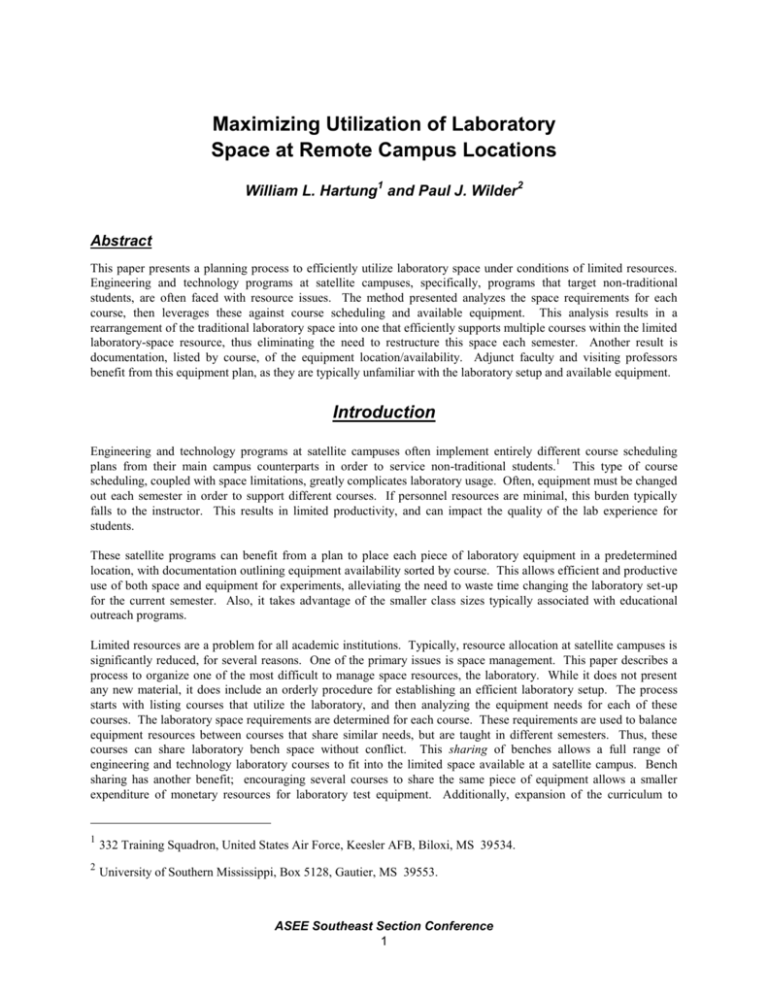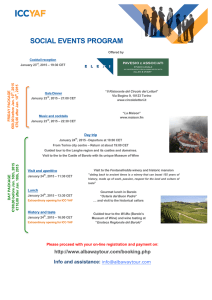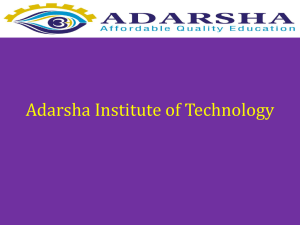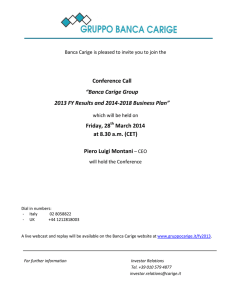Maximizing Utilization of Laboratory Space at Remote Campus
advertisement

Maximizing Utilization of Laboratory Space at Remote Campus Locations William L. Hartung1 and Paul J. Wilder2 Abstract This paper presents a planning process to efficiently utilize laboratory space under conditions of limited resources. Engineering and technology programs at satellite campuses, specifically, programs that target non-traditional students, are often faced with resource issues. The method presented analyzes the space requirements for each course, then leverages these against course scheduling and available equipment. This analysis results in a rearrangement of the traditional laboratory space into one that efficiently supports multiple courses within the limited laboratory-space resource, thus eliminating the need to restructure this space each semester. Another result is documentation, listed by course, of the equipment location/availability. Adjunct faculty and visiting professors benefit from this equipment plan, as they are typically unfamiliar with the laboratory setup and available equipment. Introduction Engineering and technology programs at satellite campuses often implement entirely different course scheduling plans from their main campus counterparts in order to service non-traditional students.1 This type of course scheduling, coupled with space limitations, greatly complicates laboratory usage. Often, equipment must be changed out each semester in order to support different courses. If personnel resources are minimal, this burden typically falls to the instructor. This results in limited productivity, and can impact the quality of the lab experience for students. These satellite programs can benefit from a plan to place each piece of laboratory equipment in a predetermined location, with documentation outlining equipment availability sorted by course. This allows efficient and productive use of both space and equipment for experiments, alleviating the need to waste time changing the laboratory set-up for the current semester. Also, it takes advantage of the smaller class sizes typically associated with educational outreach programs. Limited resources are a problem for all academic institutions. Typically, resource allocation at satellite campuses is significantly reduced, for several reasons. One of the primary issues is space management. This paper describes a process to organize one of the most difficult to manage space resources, the laboratory. While it does not present any new material, it does include an orderly procedure for establishing an efficient laboratory setup. The process starts with listing courses that utilize the laboratory, and then analyzing the equipment needs for each of these courses. The laboratory space requirements are determined for each course. These requirements are used to balance equipment resources between courses that share similar needs, but are taught in different semesters. Thus, these courses can share laboratory bench space without conflict. This sharing of benches allows a full range of engineering and technology laboratory courses to fit into the limited space available at a satellite campus. Bench sharing has another benefit; encouraging several courses to share the same piece of equipment allows a smaller expenditure of monetary resources for laboratory test equipment. Additionally, expansion of the curriculum to 1 332 Training Squadron, United States Air Force, Keesler AFB, Biloxi, MS 39534. 2 University of Southern Mississippi, Box 5128, Gautier, MS 39553. ASEE Southeast Section Conference 1 include supplemental classes in the same subject area may be accomplished, without the expense of acquiring added equipment or laboratory space resources, simply by scheduling the new course during a semester in which the required benches are available. Implementation The analysis begins with an overview of the schedule. A course listing is created inspecting each course for test equipment requirements. In order to improve laboratory efficiency, courses utilizing the laboratory are classified by equipment resource needs. Parallelism between programs provides opportunities to gain efficiency, while reducing resource requirements. For example, programs such as Electronics Engineering Technology (EET) and Computer Engineering Technology (CET) may share laboratory space. However, since there is significant overlap of topics/courses, these programs may coexist within the same laboratory space resource with little or no contention. This course/equipment list emphasizes overlapping resource requirements between courses. For example, within an EET program several courses may include component level or integrated circuit level design, resulting in the same equipment being required for each of these courses. Specifically, at the University of Southern Mississippi’s Gulf Coast campus the three-course sequence in intermediate electronics combined with classical control theory provides an opportunity to implement this plan. This sequence includes advanced devices, linear integrated circuits/operational amplifiers, HF communications, and controls. While these courses typically require similar test equipment, they are taught in separate semesters over a two-year cycle, as shown in Figure 1. As a result, they can occupy the same laboratory bench space without interference. This example considers the use of test equipment interconnected with GPIB bus technology, in order to allow computer-based control of test equipment for simulations. Once the course listing is complete, the courses and equipment are mapped onto the laboratory space. A graphic illustrating the available laboratory bench space facilitates this process. Using this graphic, assign benches to support specific courses. Figure 2 shows a plan for two laboratories, with the course numbers displayed over the benches for clarity. It is beneficial to place a label on each bench showing the courses supported. Next, the equipment is placed, according to the outline, in preparation for teaching. Equipment is grouped by application in order to facilitate orderly use. As an example, power supplies can be placed at the left, while signal sources (signal generators, audio oscillators) are placed at the center and output measurement devices (oscilloscopes, digital multimeters) are placed at the right. Additionally, meter leads, oscilloscope probes, coaxial cables, adapters and other small accessories can be placed near the work area for convenience. Enhancements Once the courses/laboratories are sorted and assigned, a further method to improve space utilization is to install swappable hard drives on the laboratory computer systems. This allows courses requiring experimentation with computer software, such as network management, programming, etc. to operate in conjunction with other laboratory courses requesting the use of these computing resources. Often these courses require bringing a system down in order to do a specific configuration/install process. The result is that all data and programmatic information on the system is lost. The process of swapping disk drives eliminates problems with potential data corruption/file deletion by other courses, assuring that students always are provided with the correct support software for the specific course they are taking. The explosion of web-based resources necessitates that the laboratory computing resources have network/Internet access, allowing students to; obtain information and data from component manufacturers, obtain access to email resources, and obtain general web access.2 Additionally, networking provides several other advantages. First, printing resources may be shared in order to economize equipment costs, and improve serviceability. Second, antivirus software/firewall management can be centralized, resulting in improved resistance to malicious-logic attacks. ASEE Southeast Section Conference 2 Another important outcome of the process described herein is the production of the continuity binder. This binder results from the compilation of the course/equipment list, and the map of the laboratory space. The continuity binder simplifies the lab usage for adjunct and visiting professors by providing a listing of equipment location, and by showing suggested station usage based on the laboratory floor plan. As such, the binder includes a detailed list of available equipment, organized by course, thus producing the additional side benefit of facilitating laboratory experiment development. This information is available in the laboratory (in both digital and paper formats) allowing instructors to make a disk copy for use during curriculum development. This document must be updated as equipment is purchased or as obsolete equipment is replaced. Conclusion The concepts outlined herein provide one option for reducing the strain on the limited resources inherent with any satellite/distance education program. This is accomplished by improving the utilization of space and equipment through an analytical process for rearranging the laboratory. This improvement has the benefit of reducing the conflict between courses. As such, no two courses share the same space during a semester, and equipment does not need to be moved each semester. The result is that the students’ ability to learn from laboratory experiments is enhanced through reduced time spent moving equipment and reassembling experiments moved by other laboratory users. Additionally, visiting professors and adjunct professors benefit from at-a-glance knowledge of the equipment available, and the space allotted, for their course. This allows faculty to devote more time to designing laboratories around the course material and available assets, without accidentally designing an experiment around a piece of unavailable equipment. Utilizing the same laboratory space for several courses during multiple semesters broadens the scope of available laboratory courses without expanding the resources required to support them. References 1 Wilder, P.: “PEPS: An Alternative Program Strategy for Non-Traditional Engineering Technology Students,” Proceedings of the American Society of Engineering Education, Southeastern Region; Marietta, Georgia, April 1997, p. 273. 2 Jack O. Beasley, “Local Area Networks in the Electronics Engineering Technology Laboratories,” Journal of Engineering Technology, Volume 6, Number 2, page 10. ASEE Southeast Section Conference 3 Tentative CET/EET Two Year Schedule Spring 2002 CET 420 & Lab CET 471 & Lab EET 312 & Lab EET 412 & Lab Summer 2002 CET 323 EET 301 Fall 2002 CET 301 & Lab CET 302 CET 370 & Lab CET 477 & Lab Spring 2003 CET 437 CET 472 & Lab CET 492 EET 315 & Lab Summer 2003 EET 301 CET 323 Fall 2003 CET 316 & Lab CET 390 EET 311 & Lab EET 461 Embedded Microcomputer Design Small Computer Systems Linear Integrated Circuits Advanced Network Analysis Advanced Analytical Applications Intermediate Network Analysis and Design Logic Circuit Design Microprocessor Architecture and Applications Hardware Systems Introduction to Control Systems Technology Advanced Programmable Devices Special Problems Design of High Frequency and Communications Circuits Intermediate Network Analysis and Design Advanced Analytical Applications Digital Communications and Computer Networks Computer Networking Fundamentals Advanced Devices Electric Power Generation and Distribution Figure 1 ASEE Southeast Section Conference 4 Station 10 EET 311, EET 312, EET 315, CET 477/ 577, Senior Projects Station 11 EET 311, EET 312, CET 477/ 577 Station 12 EET 311, EET 312, CET 477/ 577 Station 7 CET 301, CET 316, CET 471/ 571, Senior Projects Station 8 CET 301, CET 316, CET 471/ 571 Station 9 CET 301, CET 316, CET 471/ 571 LAB A Station 4 CET 302/ 501, CET 420/ 520, CET 472 /572, Senior Projects Station 5 CET 302/ 501, CET 420/ 520, CET 472 /572 Station 6 CET 302/ 501, CET 420/ 520, CET 472 /572 Station 1 CET 370, EET 412/ 512, Senior Projects Station 2 CET 370, EET 412/ 512 Station 3 CET 370, EET 412/ 512 LAB B Equipment Storage Component Testing Soldering Figure 2 ASEE Southeast Section Conference 5 Component Storage Computer Manuals Component Manuals William L. Hartung William L. Hartung received the Bachelor of Applied Science degree in Electronics Engineering Technology from Troy State University in 1997. Currently, he is a graduate student in Engineering Technology at the University of Southern Mississippi, and an instructor in Communications and Navigation Systems, assigned to the 332 Training Squadron at Keesler Air Force Base, Biloxi, Mississippi, where he acts as Network manager. His research interests include radio frequency applications and wireless Internet technologies. Paul J. Wilder Paul J. Wilder received the Bachelor of Science degree in Engineering from the University of Vermont in 1986, the Master of Science degree in Computer Engineering from the University of Central Florida in 1996, and the Master of Theological Studies degree from the University of Dallas in 2001. He is currently an assistant professor of Engineering Technology, and the Computer, Electronics, and Software Engineering Technology program coordinator at the University of Southern Mississippi's Gulf Coast campus in Gautier, MS. From 1989-1991 he held a faculty position at Vermont Technical College in Randolph Center, VT. His research interests include multiprocessor design, memory design, and embedded microcontroller systems. He has been an ASEE member since 1997, recently serving a three-year term as a member of the Engineering Technology Leadership Institute’s Executive Council, and currently as both Manuscript Editor for the Journal of Engineering Technology and Treasurer of the Engineering Technology Division of ASEE. ASEE Southeast Section Conference 6





